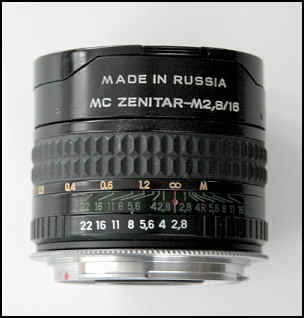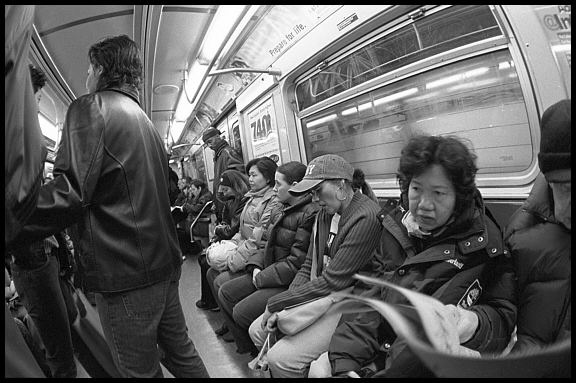
|
Zenitar 16mm f2.8 fisheye lens
Fisheye lenses are an acquired taste. They are best used in small doses, but they give a unique perspective on things. The Canon 15mm fisheye is quite expensive (around $600) so doesn't really make sense for a lens you may not use much. However there is an alternative if you don't mind manual focus and manual aperture setting. Focus really isn't much of an issue as the depth of field is so large with such a short focal length lens. Fisheye lenses "distort" the image. Lines which run through the center of the field remain straight, but lines near the top of the frame or the sides of the frame bow outwards. Used carefully the fisheye effect isn't overpowering, so for example, if you put the horizon across the middle of the frame it remains straight. However if you put the horizon near the top or bottom of the frame it will curve severely. Too many highly distorted images soon leave the viewer looking for something else, but used carefully a fisheye can give a unique wideangle perspective without forcing too many optical distortions on the viewer.

NYC subway - ©Copyright 2002 Bob Atkins The alternative to the expensive AF EOS 15mm fisheye is the Russian (actually Ukrainian) made Zenitar 16mm f2.8 fisheye. This lens has 180 degrees diagonal coverage and is available in a few different mounts including M42 and Canon EOS. I have the M42 (Pentax screw mount) lens plus an M42 to EOS adapter. The Zenitar isn't sold in many (any?) well known camera stores, but you can find them all the time on Ebay. Price depends on who is selling it, but ranges between $100 and $200. I bought mine directly from a guy in Kiev and it came about 2 weeks after I ordered it, nicely wrapped in a brown paper package and tied up with string! Some Russian/Ukrainian camera importers in the US may carry the lens. The best way to find one is via a web search engine or an Ebay search. The lens comes with red, yellow and green filters which screw on to the rear of the lens and a small carrying pouch (or at least mine did). It looks like a well built lens, the focusing is smooth and the aperture click stops work fine. The glass and coating in mine look excellent and the lens has a built in "hood", if you can call a 15mm fisheye hood a hood. It's more of a slight extension of the barrel on the top and bottom. Since the front element bulges out so far, you can't use front mounted filters and since the diagonal coverage is 180 degrees you can't just hold a filter in front of the lens either without getting it in the shot! On an EOS body I simply set the camera to Aperture Priority, set the aperture to what I want, focus the lens and let the camera select the shutter speed. Exposure seems fine. It's a fun lens, well worth the price I paid (around $110 I think). If you're looking for a fisheye and you can find a supplier you trust, I'd say go for it!
Fisheye on a Digital SLR - EOS 10DOne of the big problems with small sensor digital SLRs is getting a wide angle lens. With the 10D and Digital Rebel the small sensor gives an effective 1.6x "multiplier" (actually crop factor), so your 20mm wideangle lens mounted on a 10D gives you the same view as a 32mm lens on a full frame SLR.So what happens when you put a 16mm fisheye on a 10D? Well, you get a horizontal field of view which is about the same as that of a 20mm lens on a full frame camera - but you also get curved lines when those lines don't run through the cneter of the frame which is a characteristic of all fisheye lenses. However, since the full frame image is cropped, and the "distortion" is greatest at the edges of the frame, the smaller digital sensor "crops out" a lot of the distortion effect. Used carefully, the result scan sometimes be mistaken for shots taken with a normal rectilinear lens. Below is an examples. Note that it's shot so that most of the major straight lines go through or are close to the center of the frame:  Zenitar 16mm fisheye on EOS 10D ©Copyright 2002 Robert Atkins
Where to buy one?The Zenitar 16mm f2.8 fisheye isn't sold by many of the usual photo stores. It's worth checking out ADORAMA though. Although they don't currently (Jan '07) sell the lens new, they do sometimes carry used ones (just type "Zenitar" in their search box). The best source for the Zenitar 16mm fisheye is probably ebay. There are a number of vendors there who regularly sell the lens directly from Russia (or Ukraine). That's where I got mine from!
© Copyright Bob Atkins All Rights Reserved |
|
